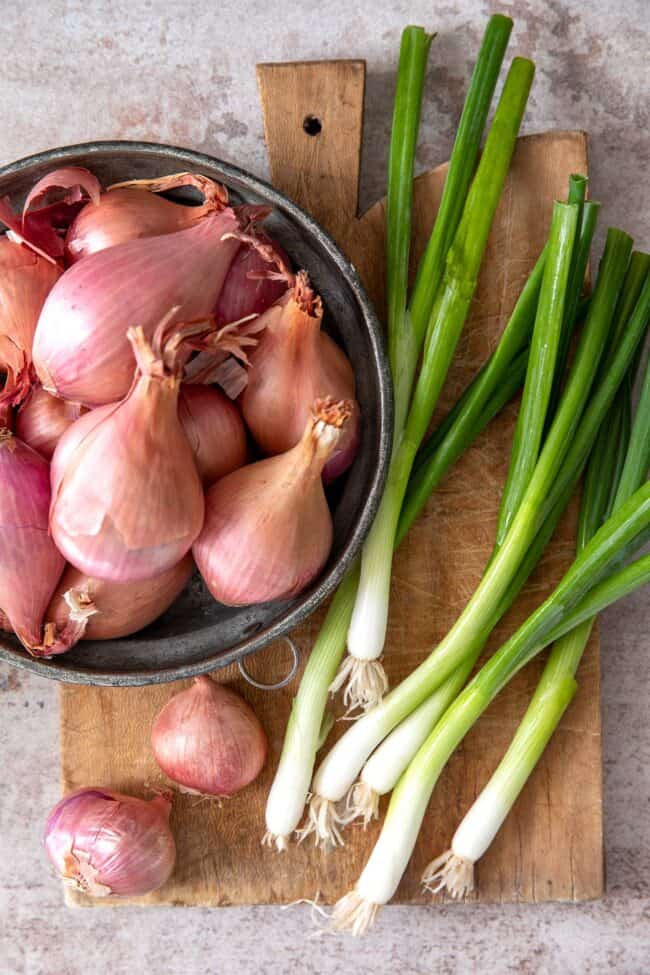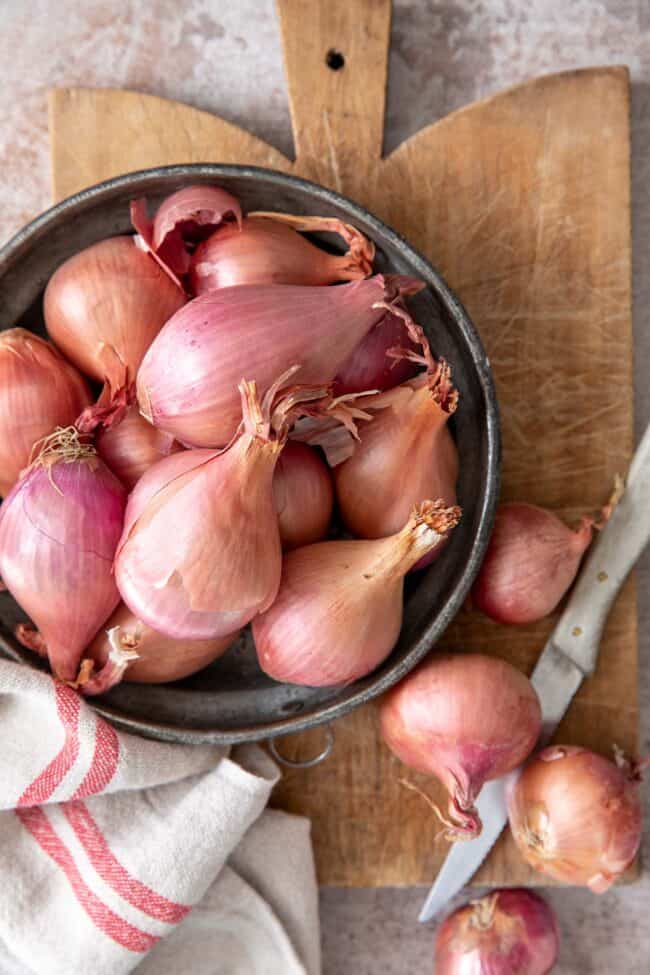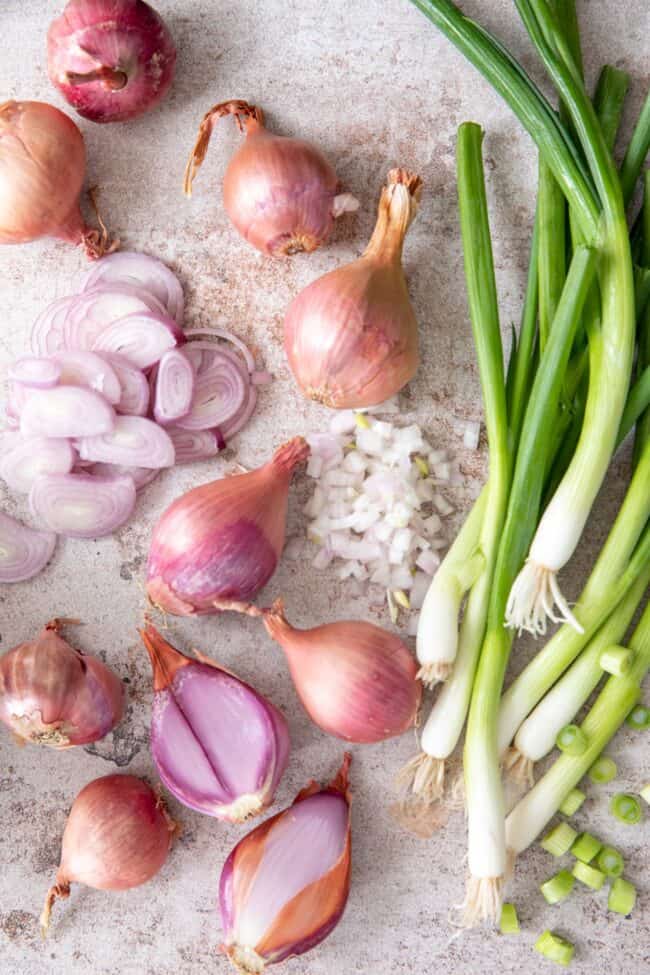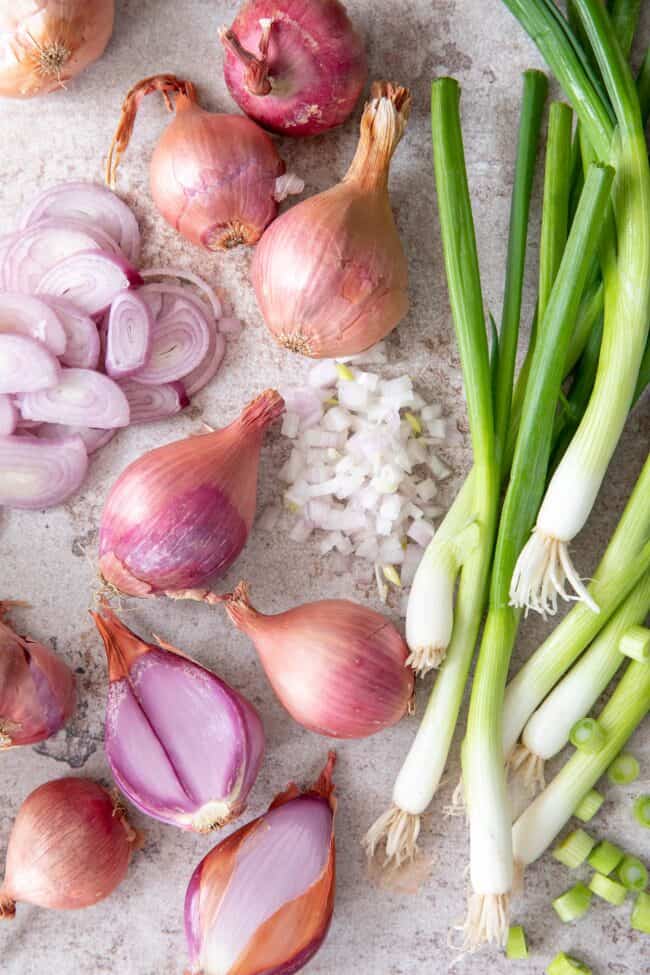Shallots vs Green Onions
Here’s everything you need to know about shallots. Like what are shallots? What’s the difference between shallots vs green onions? What’s the difference between shallots vs onions. What is a good shallot substitute? How to choose them, store them, how to cut shallots and more.
Onions and their relatives, which include shallots, leeks, green onions, chives and garlic, are known as alliums.There are more than 500 types of alliums, and all of them are edible bulbing plants, and they all have a rather distinct sharp smell and flavor.
Whether you add onions, shallots, leeks, green onions or garlic to any dish, alliums make just about everything taste better! Many recipes start out by cooking onions and garlic in a little olive oil or butter because they add so much flavor to any dish. Alliums are often referred to as aromatics because they help to create layers of flavor and an amazing aroma when they are cooked together. So what’s the difference between shallots vs green onions?
What Are Shallots?
Shallots are a small mild-flavored member of the Allium genus family, which include garlic, scallions, leeks, chives and onions. They look like both an onion and garlic, and the flavor is somewhere in between the two. Their bulbs are wrapped in a delicate papery skin similar to onions, and it’s divided into small segmented cloves similar to garlic.
What Are Green Onions?
Green onions are also a mild-flavored member of the Allium family. The term green onion is used interchangeable with scallions, but there is a minor difference. Green onions are harvested in the small bulb stage, but scallions are pulled from the soil while their tops are still green but before a bulb has formed. Unlike shallots, green onions should be kept in the refrigerator where they’ll last for about a week before going limp.
Shallots vs Onions
What’s the difference between shallots vs onions?
- Shallots look like a small red onion, but on the inside they look very different. When you peel a shallot, there are individual bulbs (like garlic) where onions have rings. Shallots have a more delicate flavor (unless they’re mature and sprouting, then the flavor can be quite strong with a bite), and onions have a more robust flavor and a little heat.
- Onions contain fewer calories than shallots (based on same serving size), but shallots are higher in many nutrients, such as fiber, vitamin B6, folate and vitamin C.
- Shallots are chosen for their delicate flavor and can be roasted, caramelized and added to salad dressings and vinaigrettes. Red onions are often eaten raw on sandwiches and burgers, where yellow onions are often used to add flavor to soups, stews and sauces, though they are also eaten raw and used as a garnish with many Mexican dishes.
- Several medium shallots equal one small onion.
In a nutshell, these are the differences between shallots vs onions!
How to Choose The Best Shallots
You’ll likely find shallots at your local market or health food store right next to garlic. Shallots and garlic are similar in how they grow, with both of them growing in bunches where onions grow individually. Choosing shallots is similar to choosing garlic. You want dry firm shallots that don’t have any sprouts or dark discolored areas. When buying green onions, look for green onions with bright green leaves and white stems. Avoid green onions that are limp or wilted or with stems turning yellowish brown.
How to Store Shallots
Like yellow and red onions, shallots are best stored in a cool and well ventilated space, where they should last up to a month. They’ll start to sprout if the temperature and/or humidity rises. If they are already peeled, chopped or cooked, they should be stored in the refrigerator in a tightly sealed container.
- Peeled. Once it’s peeled, store it in an airtight container in the refrigerator for up 1o 10-14 days.
- Chopped. Once they are sliced or chopped, they can be wrapped in plastic wrap or placed in a plastic ziplock bag in the refrigerator for up to 10 days.
- Cooked. Once cooked they can be stored in an airtight container or plastic ziplock bag in the refrigerator for up to 5 days.
How to Cut Shallots
The most abundant part of the shallot containing antioxidant flavonoids is in the outer most layers. So try not to over peel when you cut shallots. If you’ve ever wondered how to cut shallots, here’s an easy way to do it:
- Cut the top off the end of the shallot, leaving the root in tact
- Using a paring knife, make a shallow score down the outer layer of the papery skin (don’t slice all the way through the shallot)
- Peel off the papery layers and discard
- Break the bulb into two separate pieces (there’s usually two (sometimes more) separate pieces in one bulb)
- For sliced shallots – take one half and lay it flat on a cutting surface and slice into rings as thick or thin as you like
- For minced shallotsc – cut the bulbs in half lengthwise and lay on your cutting board with the cut side down. Make lengthwise slices up to the root. Then slice the middle of the shallot crosswise up to the root. Slice the root off and discard. Using a chef’s knife, use rocker back and forth motion to mince the shallot.
How to Use Them
So now that you know how to cut shallots, let’s look at some ways to use them. Besides all the great health benefits of consuming shallots, they also add tremendous flavor to so many dishes. In most recipes shallots can be used instead of onions, and vice versa. They can be sautéed, roasted, grilled or caramelized. They’re also great to add to salad dressings and vinaigrettes. And if you’re eating them raw, here’s a little tip to mellow the flavor. Peel them, then slice, chop or mince them and add to a bowl of chilled water for up to 10 minutes. Drain well and pat dry then add to your dish.
- Garnish – Use them as a garnish to Mexican dishes like Greek Chicken Bowl, tacos, fajitas, Chicken Fajita Quesadillas, posole, soups and stews.
- Salsa – Make homemade salsa and pico de gallo.
- Guacamole – Toss in with avocados, jalapeno and cilantro to make delicious Homemade Guacamole.
- Mirepoix – Make a mirepoix, which is a mix of onions, carrots and celery that are often referred to as “aromatics” that adds incredible flavor to soups, sauces and stocks.
- Salad dressings – Add them minced or blended with herbs, lemon juice and olive oil for a simple dressing.
- Chili and Soups – They add a ton of flavor to soups like this Immune Boosting Chicken Soup and chili like this White Bean Chicken Chili.
- Side dish – Combine them with vegetables to create delicious side dish recipes like this Sauteed Zucchini.
- Salads – Add them to salads like this Tuna Salad and Italian Chopped Salad.
- Pickled Onions – These Quick Pickled Onions are amazing! Add them to salads, tacos, burgers, etc.
- Stir-fry – Toss in to your favorite stir fry dishes.





